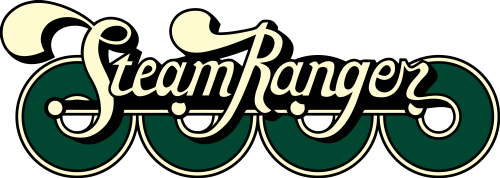Fundraising
FireUp520
520's tender was routinely drained and inspected in December 1998 after the normal running season. This confirmed previous evidence of corrosion and wastage of the underframe, where the tender had been extended down to increase water carrying capacity.
Calculations based on the static and dynamic loads on the underframe indicated that the tender frame had reached its design life, having been subjected to over 55 years of ongoing corrosion and to rectify this will require substantial strengthening and long term anti-corrosion coating. It was subsequently decided that a more cost-effective method of repair, would be to replace the entire tender, utilising modern manufacturing techniques to future-proof the locomotives future.
Mechanically, the loco is in good condition, but the boiler and smokebox need considerable attention. In 1994 the loco was converted back to a coal fired boiler by superficially covering over the oil burning apertures in the boiler backplate. This approach is not now acceptable to our boiler inspectors and initial work involving stripping fittings in the cab was commenced prior to discovering the tender corrosion problems, but has not been further progressed. A full rebuild is also required to address wasting of material in the smokebox. This will require reproducing a complicated smokebox profile.
In 2014, former ARHS tours director, the late Dean Harvey OAM, made a considerable donation toward the restoration of 520's tender, and SteamRanger is now looking for private and corporate sponsorship/donations to see this project through to completion.
As a result of Mr Harvey's donation, loco 520 now has a brand new tender, however a further funds are needed in order to repair known issues with the locomotive.
In 2021, the engine was completely stripped down, in order for a detailed investigation and costing to be undertaken to return the Whispering Giant to steam. We need your help!
Project 520 - Loco History
The 520 class was designed during World War II by F.H.Harrison, who was the Chief Mechanical Engineer of the South Australian Railways from 1939 to 1952.
New engines were urgently required because of the large increase in traffic caused by the war. As these engines were designed to operate on nearly all lines, from the heavy mainlines to the lighter branches the axle load had to be limited to 16 ton. Unique features of these engines is their streamlined appearance. fully enclosed cab and the use of roller bearings on all axles. The first engine, 520, entered service with the S.A.R. on 10 November, 1943 on the Port Pirie line achieving a maximum speed of 78 mph between Red Hill and Port Pirie.
520 was named Sir Malcolm Barclay-Harvey after the Governor of South Australia at the time of it's introduction. A total of 12 engines were built between 1943 and 1947, the later nine having a more streamlined front end than their earlier sisters. They were built as fully coal burners, but later converted to burn a mixture of coal and oil. 520 has since been converted back to a full coal burner.
The 520s were a very successful engine, so much so that they were the last of the "big" steam engines to remain in service when dieselisation arrived on the South Australian Railways' broad gauge system.
They were allowed to operate over all the broad gauge lines in the State with the exception of the Riverton-Spalding. Bumbumga-Lochiel, Sandergrove-Milang, Monarto South-Sedan, Karoonda-Waikerie, Karoonda-Peebinga, Wanbi-Yinkannie, Renmark-Barmera and Alawoona-Loxton lines. All of the lines listed above were laid with either 50 or 40 lb rails, and were therefore too light, for most of the SAR's large power locomotives. The most common use of these engines was on the Port Pine line passenger trains. They also saw service on trains to Terowie, Tailem Bend and Pinnaroo and after the widening of the gauge from Wolseley to the South East ran to Mount Gambier.
The loco was permitted a maximum passenger load of 270 tons from Adelaide to Victor Harbor, although in latter years an arbitrary limit of 240 tons has been placed on it.
The first 520 to be condemned was in 1961. 520 was condemned on 21 August 1969 and re-instated on 1 May 1970 and stored at the Mile End Railway Museum until September 1970.
In 1971-72 $20,000 was raised to allow the engine to be returned to running condition at the SAR's Islington Workshops, and on 16 May 1972 worked its recommissioning train to Sandy Creek in the picturesque Barossa Valley. Since that time, considerable expense has been incurred on other major work all of which was carried out at SteamRanger's Dry Creek, and later Mt Barker Depots.
In 1975, 520 was repainted from its black and silver colour scheme to its original green and cream livery. It's first trip in the new colour scheme was to Nuriootpa on Saturday 3rd May 1975. The engine was subsequently repainted into SteamRanger's green and yellow livery during the 1980s.
520 remained in regular service through the 1980's and 1990's including a well documented parallel run in 1989 with the ex LNER A3 'Flying Scotsman', and for a period in the late 1990's was SteamRanger's only operable large-power engine, primarily based out of Mt Barker to work Southern Encounter and Highlander services over the steeply graded Mt Barker to Strathalbyn section of the Victor Harbor branch line.
Following its withdrawal at the end of December 1998, the loco was placed into storage at SteamRanger's Mt Barker Depot, waiting for an opportunity to restore and return the locomotive to service.

